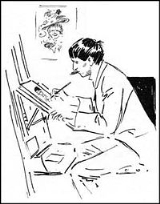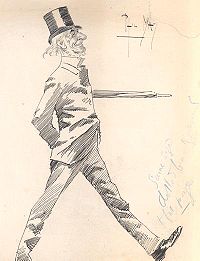
Phil May
Encyclopedia


England
England is a country that is part of the United Kingdom. It shares land borders with Scotland to the north and Wales to the west; the Irish Sea is to the north west, the Celtic Sea to the south west, with the North Sea to the east and the English Channel to the south separating it from continental...
caricaturist.
Biography
Philip William May was born at WortleyWortley, West Yorkshire
Wortley is a district of Leeds, West Yorkshire, England. It begins one mile to the west of the city centre.In the 1086 Domesday Book it is mentioned as Wirtlei, also Wirtleie and Wrleia. Later it was known as Wirkelay until about 1700...
, near Leeds
Leeds
Leeds is a city and metropolitan borough in West Yorkshire, England. In 2001 Leeds' main urban subdivision had a population of 443,247, while the entire city has a population of 798,800 , making it the 30th-most populous city in the European Union.Leeds is the cultural, financial and commercial...
, the son of an engineer
Engineering
Engineering is the discipline, art, skill and profession of acquiring and applying scientific, mathematical, economic, social, and practical knowledge, in order to design and build structures, machines, devices, systems, materials and processes that safely realize improvements to the lives of...
. His father died when the child was nine years old. His mother was the daughter of Eugene Macarthy, one time manager of the Theatre Royal, Drury Lane
Theatre Royal, Drury Lane
The Theatre Royal, Drury Lane is a West End theatre in Covent Garden, in the City of Westminster, a borough of London. The building faces Catherine Street and backs onto Drury Lane. The building standing today is the most recent in a line of four theatres at the same location dating back to 1663,...
. She was left in very poor circumstances and the family had a great struggle to exist. His grandfather, a country gentleman, had some talent as a draughtsman and liked making caricatures. At twelve, Phil May had begun to earn his living in a solicitor's office; before he was fifteen he had acted as time-keeper at a foundry, had tried to become a jockey
Jockey
A jockey is an athlete who rides horses in horse racing or steeplechase racing, primarily as a profession. The word also applies to camel riders in camel racing.-Etymology:...
and had been on the stage at Scarborough and Leeds. He was fond of drawing and when only 14 years old had drawings accepted for the Yorkshire Gossip. When he was about seventeen he went to London
London
London is the capital city of :England and the :United Kingdom, the largest metropolitan area in the United Kingdom, and the largest urban zone in the European Union by most measures. Located on the River Thames, London has been a major settlement for two millennia, its history going back to its...
with a sovereign in his pocket. He suffered extreme want, sleeping out in the parks and streets, until he obtained employment as designer to a theatrical costumier. He also drew poster
Poster
A poster is any piece of printed paper designed to be attached to a wall or vertical surface. Typically posters include both textual and graphic elements, although a poster may be either wholly graphical or wholly text. Posters are designed to be both eye-catching and informative. Posters may be...
s and cartoon
Cartoon
A cartoon is a form of two-dimensional illustrated visual art. While the specific definition has changed over time, modern usage refers to a typically non-realistic or semi-realistic drawing or painting intended for satire, caricature, or humor, or to the artistic style of such works...
s, and for about two years worked for the St Stephens Review, until he was advised to go to Australia
Australia
Australia , officially the Commonwealth of Australia, is a country in the Southern Hemisphere comprising the mainland of the Australian continent, the island of Tasmania, and numerous smaller islands in the Indian and Pacific Oceans. It is the world's sixth-largest country by total area...
for his health.
During the three years (1886–1889) he spent there he was attached to The Sydney Bulletin, or The Bulletin
The Bulletin
The Bulletin was an Australian weekly magazine that was published in Sydney from 1880 until January 2008. It was influential in Australian culture and politics from about 1890 until World War I, the period when it was identified with the "Bulletin school" of Australian literature. Its influence...
as it was better known, for which many of his best drawings were made. He produced about 800 drawings for The Bulletin. On his return to Europe
Europe
Europe is, by convention, one of the world's seven continents. Comprising the westernmost peninsula of Eurasia, Europe is generally 'divided' from Asia to its east by the watershed divides of the Ural and Caucasus Mountains, the Ural River, the Caspian and Black Seas, and the waterways connecting...
he went to Paris
Paris
Paris is the capital and largest city in France, situated on the river Seine, in northern France, at the heart of the Île-de-France region...
by way of Rome
Rome
Rome is the capital of Italy and the country's largest and most populated city and comune, with over 2.7 million residents in . The city is located in the central-western portion of the Italian Peninsula, on the Tiber River within the Lazio region of Italy.Rome's history spans two and a half...
, where he worked hard for some time before he appeared in 1892 in London to resume his interrupted connection with the St Stephens Review. His studies of the London guttersnipe and the coster-girl rapidly made him famous. His overflowing sense of fun, his genuine sympathy with his subjects, and his kindly wit were on a par with his artistic ability. It was often said that the extraordinary economy of line which was a characteristic feature of his drawings had been forced upon him by the deficiencies of the printing machines of the Sydney Bulletin. It was in fact the result of a laborious process which involved a number of preliminary sketches, and of a carefully considered system of elimination. His later work included some excellent political portraits. He became a regular member of the staff of Punch
Punch (magazine)
Punch, or the London Charivari was a British weekly magazine of humour and satire established in 1841 by Henry Mayhew and engraver Ebenezer Landells. Historically, it was most influential in the 1840s and 50s, when it helped to coin the term "cartoon" in its modern sense as a humorous illustration...
in 1896, and in his later years his services were retained exclusively for Punch and The Graphic
The Graphic
The Graphic was a British weekly illustrated newspaper, first published on 4 December 1869 by William Luson Thomas's company Illustrated Newspapers Limited....
. He was a founder member in 1898 of the London Sketch Club
London Sketch Club
The London Sketch Club was founded on 1 April 1898 as a social club for artists working in the field of commercial graphic art, mainly for newspapers, periodicals and books. The founder members were Dudley Hardy, Phil May, Walter Fowler, Lance Thackeray, Cecil Aldin, W Sanders Fiske, Walter...
. He died in 1903.
There was an exhibition of his drawings at the Fine Arts Society in 1895, and another at the Leicester Galleries in 1903. A selection of his drawings contributed to the periodical press. Examples of his work will be found at the leading Australian galleries, the Victoria and Albert Museum
Victoria and Albert Museum
The Victoria and Albert Museum , set in the Brompton district of The Royal Borough of Kensington and Chelsea, London, England, is the world's largest museum of decorative arts and design, housing a permanent collection of over 4.5 million objects...
, and the British Museum
British Museum
The British Museum is a museum of human history and culture in London. Its collections, which number more than seven million objects, are amongst the largest and most comprehensive in the world and originate from all continents, illustrating and documenting the story of human culture from its...
. From 1892-1904 there were thirteen editions of Phil May's Illustrated Winter Annual with three supplemental Summer Annuals. In addition to his Summer and Winter Annuals various collections were published, including Phil May's Sketch Book (1895), Phil May's Guttersnipes (1896), Phil May's Graphic Pictures and Phil May's A. B. C. (1897), Phil May's Album (1899), Phil May, Sketches from Punch (1903). Posthumous publications include Phil May in Australia (1904), The Phil May Folio (1904), and Humorists of the Pencil, Phil May (1908).

